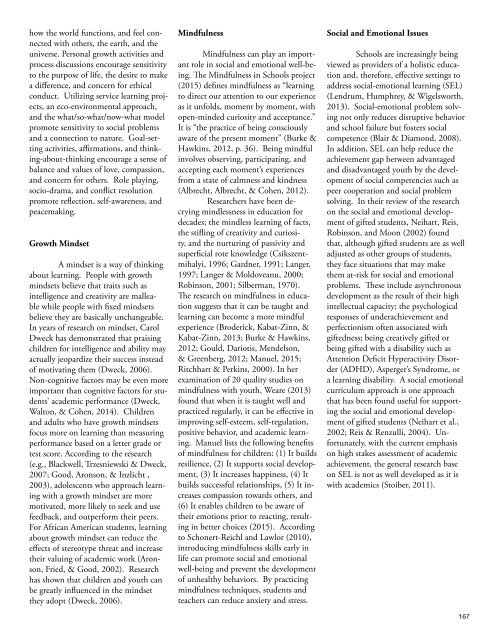Torrance Journal for Applied Creativity
TorranceJournal_V1
TorranceJournal_V1
Create successful ePaper yourself
Turn your PDF publications into a flip-book with our unique Google optimized e-Paper software.
how the world functions, and feel connected<br />
with others, the earth, and the<br />
universe. Personal growth activities and<br />
process discussions encourage sensitivity<br />
to the purpose of life, the desire to make<br />
a difference, and concern <strong>for</strong> ethical<br />
conduct. Utilizing service learning projects,<br />
an eco-environmental approach,<br />
and the what/so-what/now-what model<br />
promote sensitivity to social problems<br />
and a connection to nature. Goal-setting<br />
activities, affirmations, and thinking-about-thinking<br />
encourage a sense of<br />
balance and values of love, compassion,<br />
and concern <strong>for</strong> others. Role playing,<br />
socio-drama, and conflict resolution<br />
promote reflection, self-awareness, and<br />
peacemaking.<br />
Growth Mindset<br />
A mindset is a way of thinking<br />
about learning. People with growth<br />
mindsets believe that traits such as<br />
intelligence and creativity are malleable<br />
while people with fixed mindsets<br />
believe they are basically unchangeable.<br />
In years of research on mindset, Carol<br />
Dweck has demonstrated that praising<br />
children <strong>for</strong> intelligence and ability may<br />
actually jeopardize their success instead<br />
of motivating them (Dweck, 2006).<br />
Non-cognitive factors may be even more<br />
important than cognitive factors <strong>for</strong> students’<br />
academic per<strong>for</strong>mance (Dweck,<br />
Walton, & Cohen, 2014). Children<br />
and adults who have growth mindsets<br />
focus more on learning than measuring<br />
per<strong>for</strong>mance based on a letter grade or<br />
test score. According to the research<br />
(e.g., Blackwell, Trzesniewski & Dweck,<br />
2007; Good, Aronson, & Inzlicht ,<br />
2003), adolescents who approach learning<br />
with a growth mindset are more<br />
motivated, more likely to seek and use<br />
feedback, and outper<strong>for</strong>m their peers.<br />
For African American students, learning<br />
about growth mindset can reduce the<br />
effects of stereotype threat and increase<br />
their valuing of academic work (Aronson,<br />
Fried, & Good, 2002). Research<br />
has shown that children and youth can<br />
be greatly influenced in the mindset<br />
they adopt (Dweck, 2006).<br />
Mindfulness<br />
Mindfulness can play an important<br />
role in social and emotional well-being.<br />
The Mindfulness in Schools project<br />
(2015) defines mindfulness as “learning<br />
to direct our attention to our experience<br />
as it unfolds, moment by moment, with<br />
open-minded curiosity and acceptance.”<br />
It is “the practice of being consciously<br />
aware of the present moment” (Burke &<br />
Hawkins, 2012, p. 36). Being mindful<br />
involves observing, participating, and<br />
accepting each moment’s experiences<br />
from a state of calmness and kindness<br />
(Albrecht, Albrecht, & Cohen, 2012).<br />
Researchers have been decrying<br />
mindlessness in education <strong>for</strong><br />
decades; the mindless learning of facts,<br />
the stifling of creativity and curiosity,<br />
and the nurturing of passivity and<br />
superficial rote knowledge (Csikszentmihalyi,<br />
1996; Gardner, 1991; Langer,<br />
1997; Langer & Moldoveanu, 2000;<br />
Robinson, 2001; Silberman, 1970).<br />
The research on mindfulness in education<br />
suggests that it can be taught and<br />
learning can become a more mindful<br />
experience (Broderick, Kabat-Zinn, &<br />
Kabat-Zinn, 2013; Burke & Hawkins,<br />
2012; Gould, Dariotis, Mendelson,<br />
& Greenberg, 2012; Manuel, 2015;<br />
Ritchhart & Perkins, 2000). In her<br />
examination of 20 quality studies on<br />
mindfulness with youth, Weare (2013)<br />
found that when it is taught well and<br />
practiced regularly, it can be effective in<br />
improving self-esteem, self-regulation,<br />
positive behavior, and academic learning.<br />
Manuel lists the following benefits<br />
of mindfulness <strong>for</strong> children: (1) It builds<br />
resilience, (2) It supports social development,<br />
(3) It increases happiness, (4) It<br />
builds successful relationships, (5) It increases<br />
compassion towards others, and<br />
(6) It enables children to be aware of<br />
their emotions prior to reacting, resulting<br />
in better choices (2015). According<br />
to Schonert-Reichl and Lawlor (2010),<br />
introducing mindfulness skills early in<br />
life can promote social and emotional<br />
well-being and prevent the development<br />
of unhealthy behaviors. By practicing<br />
mindfulness techniques, students and<br />
teachers can reduce anxiety and stress.<br />
Social and Emotional Issues<br />
Schools are increasingly being<br />
viewed as providers of a holistic education<br />
and, there<strong>for</strong>e, effective settings to<br />
address social-emotional learning (SEL)<br />
(Lendrum, Humphrey, & Wigelsworth,<br />
2013). Social-emotional problem solving<br />
not only reduces disruptive behavior<br />
and school failure but fosters social<br />
competence (Blair & Diamond, 2008).<br />
In addition, SEL can help reduce the<br />
achievement gap between advantaged<br />
and disadvantaged youth by the development<br />
of social competencies such as<br />
peer cooperation and social problem<br />
solving. In their review of the research<br />
on the social and emotional development<br />
of gifted students, Neihart, Reis,<br />
Robinson, and Moon (2002) found<br />
that, although gifted students are as well<br />
adjusted as other groups of students,<br />
they face situations that may make<br />
them at-risk <strong>for</strong> social and emotional<br />
problems. These include asynchronous<br />
development as the result of their high<br />
intellectual capacity; the psychological<br />
responses of underachievement and<br />
perfectionism often associated with<br />
giftedness; being creatively gifted or<br />
being gifted with a disability such as<br />
Attention Deficit Hyperactivity Disorder<br />
(ADHD), Asperger’s Syndrome, or<br />
a learning disability. A social emotional<br />
curriculum approach is one approach<br />
that has been found useful <strong>for</strong> supporting<br />
the social and emotional development<br />
of gifted students (Neihart et al.,<br />
2002; Reis & Renzulli, 2004). Un<strong>for</strong>tunately,<br />
with the current emphasis<br />
on high stakes assessment of academic<br />
achievement, the general research base<br />
on SEL is not as well developed as it is<br />
with academics (Stoiber, 2011).<br />
167


